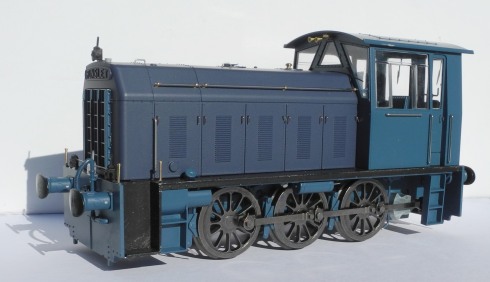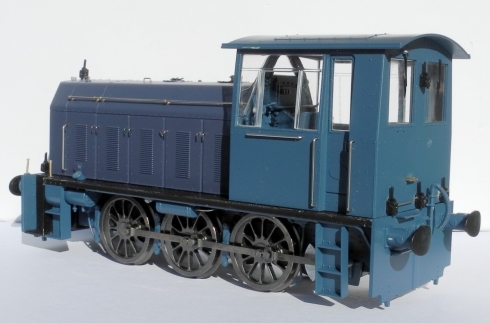Welcome to the latest edition of Workbench and your regular update from the fascinating world of Airfix modelling. We begin our latest blog with the exciting news that we have a BIG announcement for you this week and something that Workbench readers will be the first to hear about. You’ve been waiting for news of our 2017 range, and as we build towards the full 2017 range announcement we have the first exclusive reveal of a 2017 model.
Clearly, this fantastic news will be the main focus of our latest edition of Workbench, but before we begin, we would just like to say a few words regarding our previous blog, which looked back at the 2013 project to re-tool the mighty Avro Lancaster, in time to mark the 70th Anniversary of the famous ‘Dambusters’ raid. We would like to thank everyone who kindly sent us their e-mails and social media comments in support of this edition and particularly regarding the diorama build feature submitted by David Lean from Australia. This really does seem to have struck a chord with our readers and also stimulated a number of new Bomber Command related customer images submissions on the Airfix website. David has kindly supplied an update to this feature, which will be included later in this blog, but please do keep your build pictures coming, as it is always great to see how knowledgeable and creative our readers are.
Ok, we know you will be keen for us to get on with bringing you our big announcement, so without further ado, let’s get started.
The Luftwaffe deploys its Swallows

A computer rendered 3D image of the new Airfix Me 262 A-1a Schwalbe
One of the most fascinating aspects of the Second World War was the astonishing pace at which aviation technology developed over a relatively short period of time. As the world prepared for war in the late 1930s, many air forces still employed large numbers of biplane fighters to equip their front-line Squadrons and the sight of Germany’s modern, monoplane aircraft were a cause of great concern. New aircraft would be needed as a matter of urgency, but even as these fast, piston engined monoplane fighters were slowly entering service, a new propulsion technology was beginning to shape the future of aviation. As the sleek and powerful Messerschmitt Bf 109 fighters of the Luftwaffe were sweeping all before them in the skies above Poland, aviation designers in Germany were already witnessing the first flight of a new breed of aviation technology, one which would revolutionise powered flight.
When considering the multitude of successful piston engined aircraft designs of the Second World War, it is sometimes difficult to comprehend the fact that the jet engine had been in development for many years before the German invasion of Poland. Indeed, the first flight of the jet powered Heinkel He 178 took place on 27th August 1939, four days before the Wehrmacht invasion of Poland and the start of WWII and although Germany certainly had a technological lead at this stage, British designers were not that far behind. Despite these significant developments and the potential offered by the jet engine, the rigors of war would have a significant impact on slowing the pace of this development, leading to numerous what if theories as to what may have happened if the jet engine had been given absolute priority above all other production. Thankfully, this will always remain a theoretical argument, as this advanced technology would not arrive on the battlefield until the last months of WWII, at a time when Germany was under constant attack and very much on the defensive.
Without question, the Messerschmitt Me 262 Schwalbe jet powered fighter remains one of the most important aircraft of WWII and a significant development in the history of powered flight. As the world’s first operational jet powered fighter, it occupies a unique position in the history of warfare and is generally regarded as the most advanced aircraft of the Second World War. Although the German aircraft industry were certainly responsible for producing a number of ground-breaking design concepts during the latter stages of WWII, overwhelming Allied aerial supremacy dictated that all this technology would have a limited impact on the eventual outcome of the conflict and would basically be neutralised before it could become too significant a threat. There is no doubting however that these technologies would have a major impact on the post war development of aviation design and jet propulsion across the world.

Early USAAF gun camera image of the strange new Luftwaffe fighter
Allied pilots first began reporting the appearance of a strange new aircraft in the skies above Germany during the middle of 1944, much to the consternation of Allied military planners. The aircraft was reported to be capable of tremendous speed, far in excess of even the latest Allied fighters, yet did not appear to have a propeller – as these early contacts ended with the strange aircraft diving away at high speed, missions were launched specifically to investigate these reports, with reconnaissance aircraft searching for unusual activity at Luftwaffe airfields deep into Germany. They would not have to wait long for confirmation, as the first combat missions of the new Messerschmitt Me 262 jet fighter were mounted in August 1944 and clearly displayed the technological superiority of this astonishing aircraft. Heavily armed and capable of speeds far in excess of the best Allied fighters, military planners must have been fearful of the devastation these new aircraft could wreak on their bombing offensive and their continued air supremacy. How many of these fighters did the Luftwaffe have and how could they be stopped? Mercilessly hunting the new German jets was now of critical importance.
Despite the devastating impact Germany’s new jet fighter had on the air war above Germany, the tide of war had already turned and the overwhelming superiority of the Allied air forces would prove decisive. The new jet fighters were certainly a leap forward in aviation technology, but this leap came at a time when Germany was already on her knees. Germany was being pulverised from the air and Allied air superiority meant that they could mount bombing raids against any target that took their interest. This included aircraft manufacturing plants and airfields, meaning that the introduction of the Me 262 would experience significant delays and would never be available in large enough numbers to pose a concerted threat. Pilot training would have to take place at airfields deep inside Germany, but still under constant threat of Allied air attack and the initial lack of a two seat trainer version meant that pilots would have their first experience of jet-powered flight on their first sortie. Fuel and material shortages also dictated that corners would have to be cut in Me 262 production, which were both expensive and labour intensive to produce. This would have the most profound impact on the Junkers Jumo 004 jet engines that powered the fighter – these highly advanced units were originally manufactured with a no expense spared mentality, but as the Me 262 finally entered production, the cost and availability of the rare metals used could not be justified and cheaper alternatives would have to be used. This resulted in lower grade materials being used in engine construction, which were unable to withstand the high temperatures at which they would be required to operate. Even though the design of the Me 262 made it relatively easy for engineers to change an engine, they would usually be required to do so after between 10 and 25 hours flying time and in many cases, after each individual sortie.


Messerschmitt Me 262A-2a W.Nr 112372 on display at Hendon
Although the Messerschmitt Me 262 jet fighter showed great promise and offered a significant strategic advantage to the Luftwaffe, it proved virtually impossible to keep enough aircraft airworthy to have an impact on the savage battles in the skies above Germany. Perhaps the most telling statistic regarding Me 262 operations is this – on 18th March 1945, 37 Me 262s of JG.7 massed for a concerted attack against a large Allied air attack. Facing them was a force of 1,221 heavy bombers and 632 fighter escorts. Although they managed to claim twelve bombers and one fighter destroyed, for the loss of only three Me 262 jets, their technological superiority would never be able to overcome these odds and every time they took to the air, they would be hunted even as they landed at their home airfield. From an Allied perspective, thankfully the world’s first operational jet fighter would never be in a position to have the impact its advanced technology offered and simply became a prized victory target for Allied fighter pilots in the last months of WWII.
A new Airfix Messerschmitt Me 262 A-1a Schwalbe in 1/72nd scale

CAD screenshot showing the port fuselage side of the distinctive Me 262
As one of the most significant aircraft of the Second World War and certainly one of the most distinctive, the Messerschmitt Me 262 has always been a popular subject with modellers. The original 1/72nd scale version of this kit first appeared in the Airfix line-up back in 1960 and many thousands of these models have been produced since this date. It is more than likely that many Workbench readers will have enjoyed building the classic Dogfight Doubles set, featuring the Me 262 and Mosquito, which for many modellers is one of the most significant kits to appear in the Airfix range. Over recent years, modelling communities have been particularly vocal in requesting a new version of the world’s first jet fighter, which would benefit from the latest manufacturing technologies available to the Airfix team and update one of the most popular models in the history of our beloved hobby. As you will have already guessed, we are extremely pleased to be able to confirm that a new Messerschmitt Me 262 A-1a is on the way and is currently scheduled to be available in early 2017.

The Airfix research team had access to the preserved Me 262 at Hendon

A flying Great White shark – the unmistakable profile of the Schwalbe
Taking on some of the most iconic aircraft ever to take to the skies has never been something that has phased the talented designers at Airfix, who have a highly effective system for producing accurate and highly detailed scale replica kits for us all to enjoy building. At the outset of any new tooling project, the team endeavour to obtain as much accurate research detail as they possibly can, which in the case of the Messerschmitt Me 262 included information from their own extensive library and securing excellent and highly accurate technical drawings from a respected aviation draughtsman. This information was backed up with the invaluable opportunity to closely inspect the Me 262A-2a W.Nr 112372, which is on display at the RAF Museum, Hendon. The team were able to take accurate measurements from this genuine wartime aircraft, along with a large number of photographs, detailing every aspect of the construction of this beautiful aircraft.
Perhaps the most impressive stage in how the team bring a new model project to life is the process by which they take all this research data and computerise the information, producing base model files which will be central to every aspect of the new model’s development. Once they have these computerised base model files, they can use powerful software to check every aspect of its design for shape and accuracy, with even the finest detail easily accessible. Individual component parts can be developed with incredible accuracy, as the software allows everything from the entire fuselage to an undercarriage strut to be designed and inspected in impressive detail. Always conscious of the scale in which the new model will be produced, these digital files allow designers to create model components that are as accurate as current injection moulding tolerances will allow, but always challenging themselves to push these manufacturing boundaries.



A selection of CAD screenshot images from the new Messerschmitt Me 262 A-1a project
From the modeller’s perspective, we are always extremely keen to see images of the latest new tooling announcements from Airfix, which is another area where this impressive design software comes into its own. It can be used to produce computer rendered 3D images of the base model files and whilst this does require no small amount of skill on the part of the designer charged with completing this work, it really does bring the project to life. Whilst these magnificent images are an important step in the design process of any new model project and allow us all to see what the final model may actually look like, they are actually produced quite early in the design process and are shown in Workbench on the understanding that they may be altered before the final model is released for production. Nevertheless, this type of image is now familiar to the Airfix modeller and helps to increase our excitement levels with the announcement of a new model tooling.



This selection of beautiful computer rendered 3D images give us a tantalising glimpse of what the new model will look like
We have included a selection of computer rendered 3D images of the new Messerschmitt Me 262 tooling throughout this blog, which identify the aircraft as an Me 262 A-1a version of this highly significant warplane. At the outset of this project, the Airfix designers were determined to produce a highly accurate representation of the world’s first jet fighter, in the certain knowledge that this would be high on the future build schedule of many a modeller. From their detailed inspection of the Schwalbe on display at Hendon, they could see that many previous kits of the Me 262 on the market had failed to accurately represent the detail visible from inside the main undercarriage bays and they were determined to put this right. Of particular note are the use of service apertures in the base of the pilot’s bathtub cockpit area, which allow engineers to access the cockpit from underneath the aircraft, through the main undercarriage bay – this is the type of detail the Airfix designers were looking to incorporate within their new model.

This wireframe CAD screenshot shows the unmistakable profile of the world’s first operational jet fighter
Due to the fact that the combat introduction of the Messerschmitt Me 262 came too late to affect the outcome of the air war over Germany towards the end of the Second World War, it would not be entirely accurate to describe the aircraft as Germany’s best fighter of WWII. It did herald the dawning of a new age in aviation technology and performance and had Germany’s position not been so perilous at this stage of the war, could have had a devastating impact on the eventual outcome. Described by famous British test pilot Eric ‘Winkle’ Brown as the most formidable aircraft of WWII, the Me 262 was a quantum leap in aviation performance terms and stands as one of the most significant aircraft in the history of flight. This new 1/72nd scale tooling from Airfix will take its place in a growing range of newly tooled aircraft from WWII and update one of the most popular models in the history of the company. We look forward to bringing you many more updates as this exciting project progresses.”






















